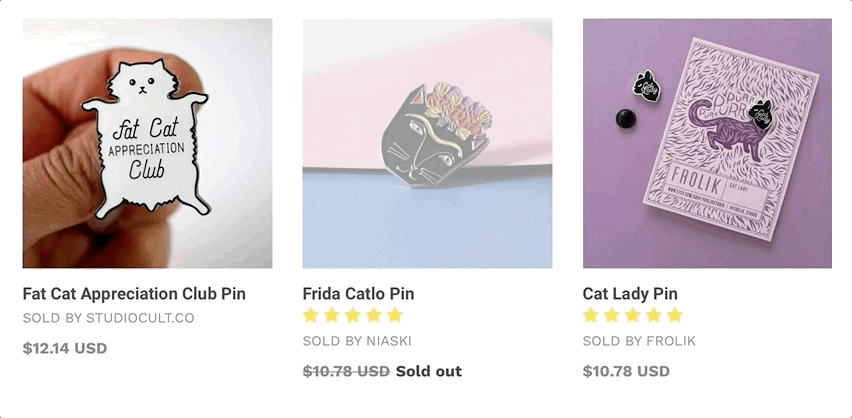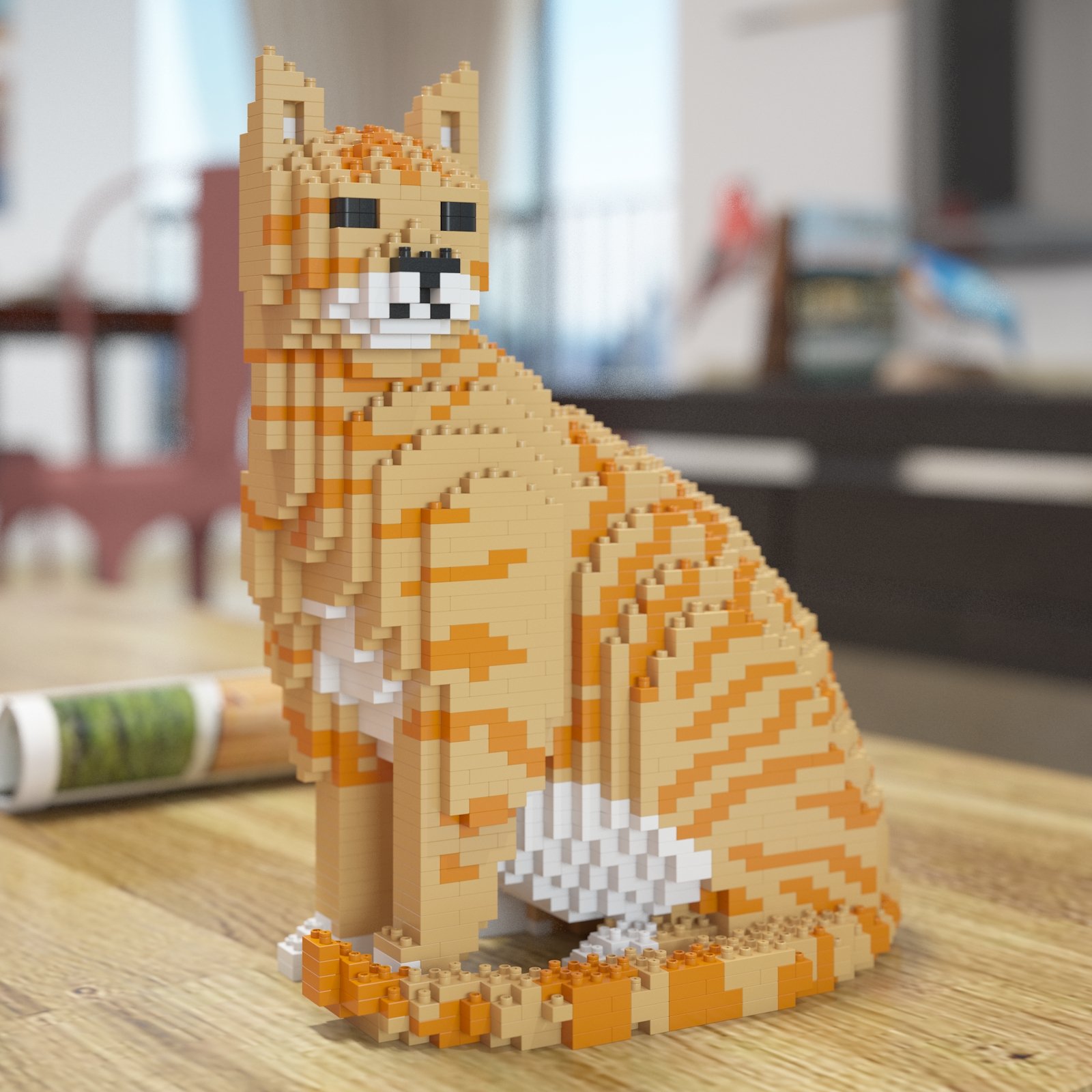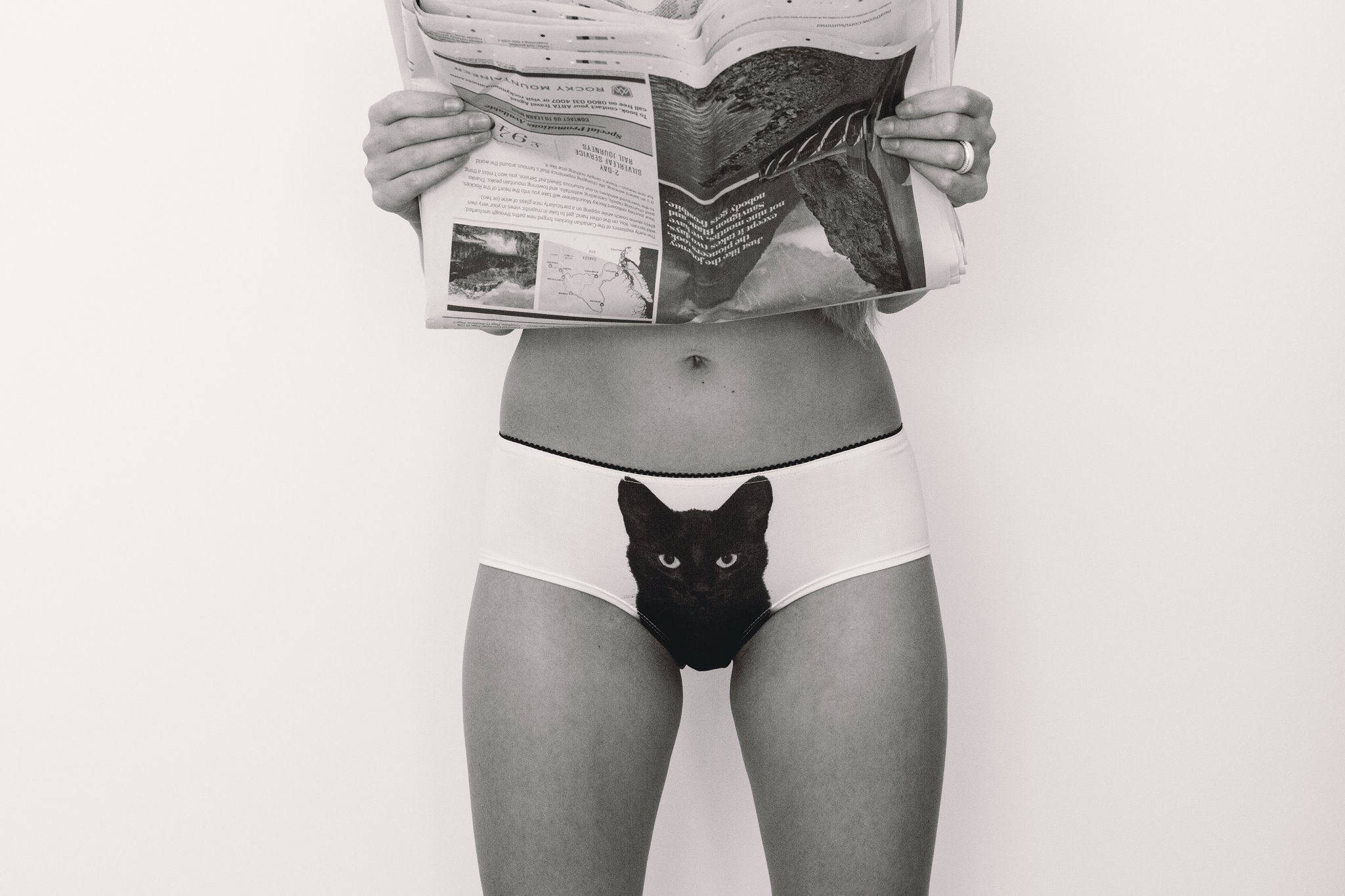How a Just-for-Fun Instagram Account Inspired Us to Build a Business
Hello! What's your background, and what are you working on?
Hi! My name is Bregt and I'm a digital product manager currently working on Twoo, an app to meet new people. I'm also running Katt. as a side project with my partner Alejandra from our home in Bruges, Belgium.
Katt. is an e-commerce platform featuring feline-inspired items from designers and illustrators, and was born out of our mutual love of all things feline. We introduce our customers to exclusive collaborations from some of the most relevant independent artists and creatives, showcasing their work and supporting the artists behind them. Katt. was featured on Product Hunt on Halloween this year.

Next to taking care of business, Kiki and I also lovingly manage our newly blended family of eight: two girls, two boys, and two cats.
We started our side project in October of 2017 and have acquired over 1,000 customers to date. We are now making about $3,000 in monthly revenue.
What motivated you to get started with Katt.?
Katt. didn't start as an e-commerce business. We wanted to express our admiration for cats and plants and created a dedicated Instagram account. The response was overwhelming and we quickly gathered a devoted follower base. Our Instagram now has over 10k followers and it's still growing quickly.
The idea to sell online has always been lurking in the back of my head. With our Instagram gaining popularity, I saw an opportunity to actually start my own e-commerce business.
What went into building the initial product?
Both Alejandra and I have day jobs that we love and don't intend to leave, so we knew time was not on our side and we would have to be creative to get things off the ground. When we created Katt., we made a strategic decision to build it as a platform to connect designer and customer, and not position ourselves as sellers. We started with a few carefully selected products and designers, each selling directly to a cat-loving target group. The artists take care of shipping and handling, and ship directly to the customer themselves.
By doing it this way, we were both able to do what we are good at — and only that — as we didn't have to worry about the logistics that come with running an international e-commerce business. Alejandra searched for designers and makers that showed potential, and I started creating an appealing store to showcase them. Since I was not a developer and did not having a lot of financial resources, I turned to Shopify, which enabled us to create an online store quickly and easily. We simply took the default theme that was pre-installed, registered a domain, and we were up and running in less than a day.
How have you attracted users and grown Katt.?
We got a head start with our Instagram account since it had already gained some traction. Instagram is an incredible tool to get products in the face of their target audience, but the shift from posting photos of cats and plants to showcasing our cat themed products didn't go smoothly. Though the number of likes on each post plummeted and the growth slowed down, we knew we had to be persevere.
Our luck turned around when Abadesi from the Product Hunt community team spotted our Instagram account and asked us if we were ok with having Katt. featured on their platform. She wanted to showcase the diversity of makers on Product Hunt and thought we were a perfect fit. We were a bit hesitant at first since our product was only a few weeks old, but we agreed. Katt. was also part of a new series on Product Hunt called Makers' Stories, highlighting unique products and the people behind them from across the world. We're also really proud to count Ryan Hoover, Product Hunt's founder, as one of our customers — he bought one of our Lego-inspired Cat Sculptures.

Since then, we've kept the ball rolling and continued to grow. Word about Katt. spread even further after we created our own blog series featuring more in-depth stories about our designers, called Meet The Makers. The designers posted their interviews on their own social media accounts, which introduced their audience to the other designers and products on the site. It really helped having a clearly defined target audience of cat and design lovers, as each interview served to boost sales for the other designers.
Of course, including cat gifs and the occasional cat pun in our emails also helped to increase the click-rates of both our transactional emails and newsletters :).
What's your business model, and how have you grown your revenue?
From a tax and logistics perspective, there are many obstacles to overcome when selling online internationally. You have to be aware of the local rules that apply to each country that you sell and ship to. When discussing this with my accountant, Michael Vandenhende — whom I highly recommend if you're starting up a business in Belgium — we knew we had to get creative to be able to ship worldwide on a tight budget, and still be able to scale quickly when needed.
This is why we developed the business plan of having the artists sell directly rather than acting as the sellers ourselves. Each time someone places an order through Katt., they are buying directly from the artist, who then receives and fulfills the orders with a custom Katt. branded packing slip they print and add to the packages that they sent out. This allows us to avoid many of the complications of international taxation and shipping logistics, and frees us up to focus on other aspects of the business.

For each sale we make, we take a 30% commission. In return, we take care of adding the artist products to the platform, marketing them, and doing customer care. It's a win-win situation. We invests a lot to help the artists sell their products through a multi-channel approach. We promote products and sales through:
- Partnerships with different publishers in the design industry that write about products featured on Katt.
- Discount promotions for our customers (the discount comes out of our profit)
- Online advertising through Google AdWords and different social media channels, such as Facebook and Instagram
- High engagement through active social media presence
- Newsletter marketing
More recently, we created apps for both iOS and Android phones. While Katt. is a very niche store — unlike Etsy, for example — I still believe there are some major advantages to having a dedicated app. We now have the ability to reach our customers through push notifications, a very powerful marketing tool. It also opens up the opportunity to post our apps on app review sites, create a press releases, and do many more app related marketing activities.
Monthly revenue data points:
| Month | Revenue |
| October 2017 | 1056 |
| November 2017 | 2946 |
| December 2017 | 3273 |
| January 2018 | 1410 |
| February 2018 | 3297 |
| March 2018 | 5454 |
Note: March revenue only accounts for the 1st through the 21st.
What are your goals for the future?
This might sound unambitious, but the aim with Katt. from a business perspective is to keep it as a side project that is not consuming huge amounts of time, while still making it really scalable. Alejandra and I both like our jobs a lot and prefer working on something like this instead of spending our evenings binge watching Netflix.
The idea is to automate as much as possible, from posting on social media to placing the orders. All of the money that goes into Katt. is either to increase the efficiency of the processes, or to promote the products. Being able to send the orders out to the artists, including packing slip and all other information, without any human intervention is something we'd like to have in the very near future. This way we can focus on what really matters: showcasing the work of independent makers and supporting the artists behind them.
Where can we go to learn more?
We would love to get your feedback on our side-project. Leave your comments below and we'll get in touch. We're also happy to help out people who feel inspired by our project!
Find us here:
- Website: https://katt.co
- Instagram: https://instagram.com/katt_co
- Facebook: https://facebook.com/kattcompany
- Twitter: https://twitter.com/katt_co
- iOS App: https://itunes.apple.com/app/katt/id1356536995
- Android App: https://play.google.com/store/apps/details?id=co.katt.app

Nice work Bregt! Super insightful read :)
This is awesome! I also work a lot on automation for my business, and have an in house solution to sending invoices from shopify to my third party sellers.
I need to polish it up and get the UI less shitty, but I can't really get to it until summer :(
Thanks & that's great to hear! Mind sharing the link to your store?
discountfannypacks.com
But I have to shut it down because it was a test. I do lots of E-commerce like this in addition to my development projects and school :)
This is such a solid strategy for this niche. Connecting designers to customers. Great work guys!
Thanks James!
Great article and really showcases the power of niching down and getting the perfect market fit before you open the doors of commerce
Thanks @bootstrapCHILA !
Very cool story Bregt! Can you share what marketing or other apps you use to reach out to connect with your users?
From what I gather...
Thanks @aeto! That pretty much sums it up!
The emails are collected on the site via MailChimp (there is an app for that) + via Intercom, which is pushed via Zapier to MailChimp (sounds complicated, but it's not)
Intercom is a really great tool, they allow you to send messages to visitors based on all kinds of behavior, really cool to play around with. They also have a special offer for small start-ups (you should ask for it). For all the other tools I use the free versions which work just fine.
Gotcha thanks for the additional info!
Have you thought about connecting those different systems together to see what convinces users to buy? Something like.. if a user follows your IG, and is subscribed to your MailChimp, then sending a personalized email based on what kind of IG posts they like has a much higher chance of conversion
Could be more work than it's worth right now though as you guys are moonlighting :)
That's a great idea @aeto ! I do think it probably works best for large marketplaces with many different products that appeal to many different buyers. That said, MailChimp has some functionality built in that sends automated mails based on the products people visited on the site (eg. Seen something you liked?) - they perform pretty well but are still pretty low volume as you need the email and an account on your store. We also do some retargeting campaigns with Shoelace with some success, but if there is one advice I would give to people starting in e-commerce: don't start with the ad-game before you're really sure you have your conversions covered. Try different (free) approaches before turning to paid ads.
Oh, and I forgot to mention PushOwl, which I'm using for browser notifications, they have a great integration with Shopify, including abandoned carts notifications. We're running on their advanced plan for free as we were one of their first integrations and gave them feedback along the way. It's run by two great guys, customer service is amazing.
Thanks for sharing. How'd you get your app built? Are they both native to their platform respectively? Why'd you pick the path you did with respect to those apps?
You're welcome, @LeRoyG. The apps are so-called wrapper apps and have very limited native functionality. Both apps were build using Gonative.io - if you have some technical background, it's a great and affordable way to publish apps based on your mobile website.
The main reason we choose to focus on the apps is contact-ability. You need to be able to contact every single visitor to your product. Apps allow you to do just that, for free - with push notifications. We configured a complete path with different push notifications to each new app user using Onesignal. We also do email campaigns with MailChimp - but the conversions for push notifications are a lot better, in the range of 20-25% click-rate, compared to 6% click rate on the emails. The push notifications are also sent to people at the time they are most likely to open them, based on the time they last used the app. I haven't seen any email service doing that kind of thing and certainly not for free.
Hi, the website looks great! May I know which Shopify marketplace you use? Thanks
Thanks, @simoci! We use a basic Shopify store but we might upgrade to the next plan or advanced plan as the commission on each sale is lower - and it will start making sense revenue-wise to do that. The theme we're using is the completely out-of-the box Debut theme, Shopify's signature theme that is installed as default.
Hi @bregt
Thanks for the quick response. I can't find the marketplace plugin you used for your website in the links provided. Did you use https://apps.shopify.com/multi-vendor-marketplace?
We are not using a specific Shopify app to make it a multi-vendor marketplace - instead we hack our way into it using the collections functionality that is build right into Shopify.
Hi, how are you able to manage a marketplace on Shopify, and how are the orders passed on to the designers?
Lots of interesting stuff here, thanks! I would like to hear more about how you source artists - Where do you find them? How do you convince them to come on board? How do you decide who is small enough to approach or who is too big to approach for your stage? (If you even do?)
Thanks @Nilef ! The first artist we contacted was through Instagram - after we sent a brief message if they'd be interested in selling on Katt. we got a positive response almost immediately and we got started the same day. It didn't always go that easy though.
At Katt. we bring the most exciting feline inspired designers together under one roof. We open our doors to design talents that are blessed with an exciting uniqueness. We cater even to the most edgy designers with a small commercial audience.
When selecting artists we look at more than simply people that are offering unique and outspoken products that fit the target audience:
We keep a list of every artist we contact, with all information we can find (website, reviews, social media accounts with number of likes/followers, amount of sales, ...) and the time we contacted them. Most of the time, they will not respond to our first message, so it's important to know when to send a follow up message and even a second and third follow up. Luckily many do answer a follow up message.
To come up with a message that they respond to, we did some A/B testing with different messages. Having a very short initial message usually works best. We tell the designer that we checked them out and what products we love. Giving them all the details in the first message, doesn't get you a foot in the door.
Hi Bregt thanks for sharing! What prompted you to transition from just an instagram of cat pics to products for cat lovers? Did you do any research on it? thanks!
Hi @tamrat, thanks for your reply! The response to the Instagram account was so overwhelming, there was just so many opportunity simply sitting there waiting to be picked up. I'm an avid cat lover myself too - it seemed like the logic next step.
No "real" research has been done on it - although I seem to remember that Friskies once asserted that 15 percent of internet traffic is cat-related. An impressive statistic, given that it is generally accepted that about 30 percent of all internet traffic is porn-related. So basically cats account for half as much traffic as porn. Research done :D
Love this methodology. Also Bruges is so beautiful, hope to visit again soon!